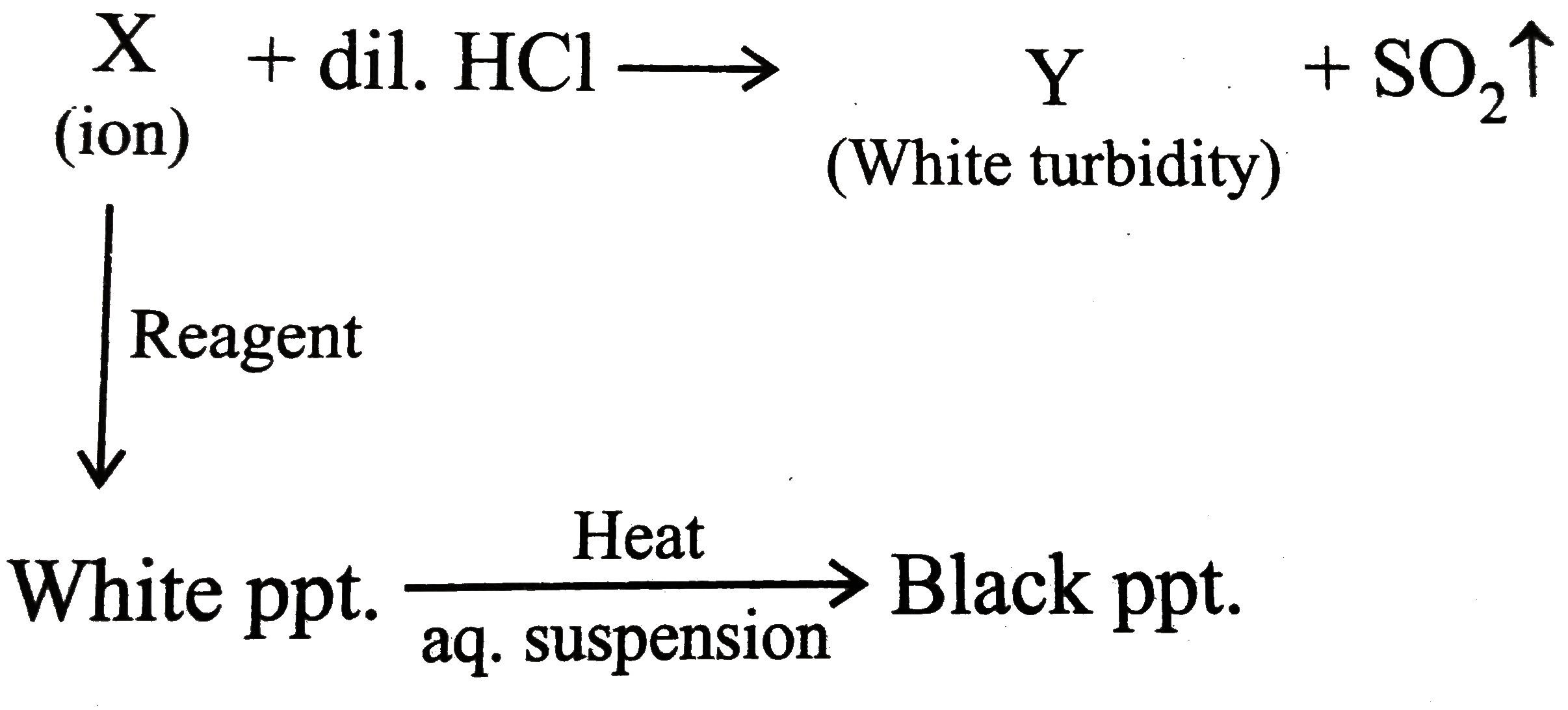Which of the following aqueous solution of cation(s) give(s) white ppt. with NaOH and NH4OH solution and formed ppt. is/are further completely dissolved in one of the excess reagent?
Cd2+
Cr3+
Sn2+
Bi3+
The correct Answer is:A, C
To solve the question, we need to analyze the behavior of the given cations (Cadmium Cd2+, Chromium Cr3+, Tin Sn2+, and Bismuth Bi3+) when they react with sodium hydroxide (NaOH) and ammonium hydroxide (NH4OH). We will look for those that form a white precipitate and can dissolve in one of the excess reagents.
1. Cadmium Cd2+:
- When Cd2+ reacts with NaOH, it forms a white precipitate of cadmium hydroxide Cd(OH)2.
- In excess NaOH, Cd(OH)2 is not soluble.
- In excess NH4OH, Cd(OH)2 is soluble and forms the complex Cd(NH3)2+4.
- Conclusion: Cadmium Cd2+ gives a white precipitate and is soluble in excess NH4OH.
2. Chromium Cr3+:
- When Cr3+ reacts with NaOH, it forms a green precipitate of chromium hydroxide Cr(OH)3.
- In excess NaOH, Cr(OH)3 is soluble and forms the complex NaCr(OH)4.
- In excess NH4OH, it forms Cr(NH3)3+6 which is also soluble.
- Conclusion: Chromium Cr3+ does not give a white precipitate.
3. Tin Sn2+:
- When Sn2+ reacts with NaOH, it forms a white precipitate of tin hydroxide Sn(OH)2.
- In excess NaOH, Sn(OH)2 is soluble and forms the complex Na2Sn(OH)4.
- In excess NH4OH, it is not soluble.
- Conclusion: Tin Sn2+ gives a white precipitate and is soluble in excess NaOH.
4. Bismuth Bi3+:
- When Bi3+ reacts with NaOH, it forms a white precipitate of bismuth hydroxide Bi(OH)3.
- In excess NaOH, Bi(OH)3 is not soluble.
- In excess NH4OH, it is also not soluble.
- Conclusion: Bismuth Bi3+ gives a white precipitate but is not soluble in either reagent.
Final Answer:
The cations that give a white precipitate with NaOH and NH4OH and are soluble in one of the excess reagents are:
- Cadmium Cd2+ (soluble in excess NH4OH)
- Tin Sn2+ (soluble in excess NaOH)
Thus, the correct options are A (Cadmium Cd2+) and C (Tin Sn2+).
- When Cd2+ reacts with NaOH, it forms a white precipitate of cadmium hydroxide Cd(OH)2.
- In excess NaOH, Cd(OH)2 is not soluble.
- In excess NH4OH, Cd(OH)2 is soluble and forms the complex Cd(NH3)2+4.
- Conclusion: Cadmium Cd2+ gives a white precipitate and is soluble in excess NH4OH.
- When Cr3+ reacts with NaOH, it forms a green precipitate of chromium hydroxide Cr(OH)3.
- In excess NaOH, Cr(OH)3 is soluble and forms the complex NaCr(OH)4.
- In excess NH4OH, it forms Cr(NH3)3+6 which is also soluble.
- Conclusion: Chromium Cr3+ does not give a white precipitate.
- When Sn2+ reacts with NaOH, it forms a white precipitate of tin hydroxide Sn(OH)2.
- In excess NaOH, Sn(OH)2 is soluble and forms the complex Na2Sn(OH)4.
- In excess NH4OH, it is not soluble.
- Conclusion: Tin Sn2+ gives a white precipitate and is soluble in excess NaOH.
- When Bi3+ reacts with NaOH, it forms a white precipitate of bismuth hydroxide Bi(OH)3.
- In excess NaOH, Bi(OH)3 is not soluble.
- In excess NH4OH, it is also not soluble.
- Conclusion: Bismuth Bi3+ gives a white precipitate but is not soluble in either reagent.
The cations that give a white precipitate with NaOH and NH4OH and are soluble in one of the excess reagents are:
- Cadmium Cd2+ (soluble in excess NH4OH)
- Tin Sn2+ (soluble in excess NaOH)
Topper's Solved these Questions
- QUALITATIVE INORGANIC ANALYSISBOOK - VK JAISWAL ENGLISHCHAPTER - QUALITATIVE INORGANIC ANALYSISEXERCISE - MATCH THE COLUMN
4 Videos
- QUALITATIVE INORGANIC ANALYSISBOOK - VK JAISWAL ENGLISHCHAPTER - QUALITATIVE INORGANIC ANALYSISEXERCISE - ASSERTION-REASON TYPE QUESTIONS
14 Videos
- QUALITATIVE INORGANIC ANALYSISBOOK - VK JAISWAL ENGLISHCHAPTER - QUALITATIVE INORGANIC ANALYSISEXERCISE - LEVEL 3
62 Videos
- PERIODIC PROPERTIESBOOK - VK JAISWAL ENGLISHCHAPTER - PERIODIC PROPERTIESEXERCISE - MATCH THE COLUMN
11 Videos
- s-BLOCK ELEMENTSBOOK - VK JAISWAL ENGLISHCHAPTER - s-BLOCK ELEMENTSEXERCISE - SUBJECTIVE PROBLEMS
2 Videos
Similar Questions
Knowledge Check
Which of the following complex will give white ppt. with BaCl2 solution ?
A[Co(NH3)5SO4]BrB[Co(NH3)5Br]SO4C[Co(NH3)4(SO4)2]BrD[Co(NH3)4Br(SO4)]
Which of the following ppt (s) of sulphite ion have white colour ?
View SolutionWhich of the following ppt is insoluble in NH3 solution ?
View SolutionWhich one of the following does not give a precipitate with excess of both NaOH solution and NH3 solution ?
View Solution
Which of the following cation may be present in white ppt ?
View SolutionWhich of the following white ppts are insoluble in NH3?
View SolutionWhich of the following complex(s) will have blue colour solution or ppt ?
View SolutionWhich of the following compound do not have white colour in the form of ppt ?
View Solution
